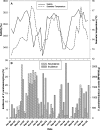Environmental determinants of the occurrence and distribution of Vibrio parahaemolyticus in the rias of Galicia, Spain
- PMID: 17981951
- PMCID: PMC2223222
- DOI: 10.1128/AEM.01307-07
Environmental determinants of the occurrence and distribution of Vibrio parahaemolyticus in the rias of Galicia, Spain
Abstract
Infections associated with Vibrio parahaemolyticus on the coast of Galicia (in northwestern Spain) were reported to be linked to large outbreaks of illness during 1999 and 2000. Little information is available about the ecological factors that influence the emergence of V. parahaemolyticus infections in this temperate region. We carried out a 3-year study to investigate the occurrence and distribution of V. parahaemolyticus at 26 sites located in the four main rias of Galicia in association with environmental and oceanographic variables. V. parahaemolyticus was detected in all the areas investigated and throughout the complete period of study with an overall incidence of 12.5%. Salinity was the primary factor governing the temporal and spatial distribution of V. parahaemolyticus, whereas seawater temperature had a secondary effect and only modulated the abundance in periods and areas of reduced salinities. Higher occurrence of V. parahaemolyticus was observed during periods of lower salinity in autumn, with a total of 61 positive samples (18%) and a mean density of 1,234 most probable number/100 g. V. parahaemolyticus was primarily detected in areas of reduced salinity close to freshwater discharge points, where it was found in up to 45% of the samples. Characterization of the isolates obtained from the study resulted in the first identification of two pathogenic tdh-positive strains of V. parahaemolyticus recovered from the marine environment in Galicia. These isolates showed serotypes identical to and DNA profiles indistinguishable from those of the clinical clone of V. parahaemolyticus dominant in infections in Spain in the last 10 years.
Figures





References
-
- Alvarez-Salgado, X. A., J. Gago, B. M. Miguez, M. Gilcoto, and F. F. Perez. 2000. Surface waters of the NW Iberian margin: upwelling on the shelf versus outwelling of upwelled waters from the Rias Baixas. Estuar. Coast Shelf Sci. 51:821-837.
-
- Anonymous. 2001. Opinion of the scientific committee on veterinary measures relating to public health on Vibrio vulnificus and Vibrio parahaemolyticus. European Commission, Brussels, Belgium.
-
- Baffone, W., R. Tarsi, L. Pane, R. Campana, B. Repetto, G. L. Mariottini, and C. Pruzzo. 2006. Detection of free-living and plankton-bound vibrios in coastal waters of the Adriatic Sea (Italy) and study of their pathogenicity-associated properties. Environ. Microbiol. 8:1299-1305. - PubMed
-
- Bej, A. K., D. P. Patterson, C. W. Brasher, M. C. Vickery, D. D. Jones, and C. A. Kaysner. 1999. Detection of total and hemolysin-producing Vibrio parahaemolyticus in shellfish using multiplex PCR amplification of tl, tdh and trh. J. Microbiol. Methods 36:215-225. - PubMed
MeSH terms
LinkOut - more resources
Full Text Sources

